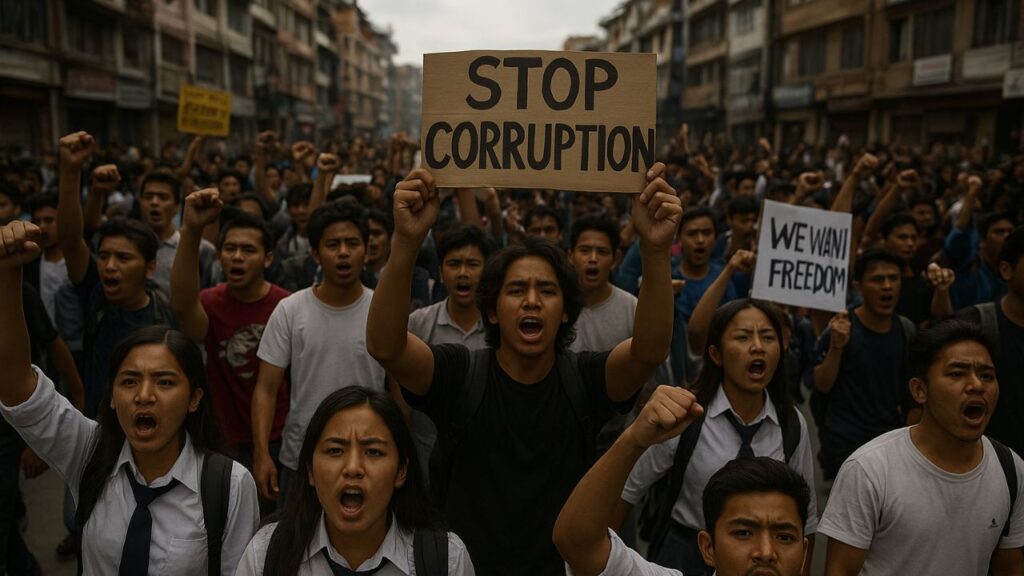
Young Nepalese, known as Gen Z (born between 1997 and 2012), make up nearly 40% of the population. (Representational AI generated image)
Nepal is in turmoil. Tens of thousands of young people have taken to the streets, demanding change. What started as a protest against a sudden social media ban turned into the largest youth-led movement in Nepal’s recent history. The crisis has shaken the government and left the country in political uncertainty.
What Triggered the Nepal Protests?
On 4 September 2025, Nepal’s government banned 26 major social media platforms. That included Facebook, WhatsApp, X (formerly Twitter), Instagram, and YouTube. The official reason was that these companies didn’t follow new registration rules meant to enforce taxes and regulations.
But many saw a different reason. The ban came right after a viral hashtag — “Nepo Kids” — spread online. It exposed how the children of politicians lived lavishly while many Nepalese struggled in poverty.
This felt like the last straw for many young people.
The Bigger Picture
The social media ban wasn’t the only issue. Young Nepalese, known as Gen Z (born between 1997 and 2012), make up nearly 40% of the population. Yet, they face huge problems:
- Unemployment is around 20%
- Economic growth is stagnant
- One-third of Nepal’s GDP comes from remittances as millions leave for work abroad
Many feel left out of politics. Corruption is widespread. Leadership is unaccountable. Reforms promised since the republic was established in 2008 never happened. For many young people, social media became the only place to speak up and connect, especially when their families live between Nepal and other countries.
How It All Unfolded
When the ban started, tens of thousands of young people, many wearing school uniforms, marched through Kathmandu and other cities. They used online groups to organize, not traditional political parties.
At first, they demanded the social media ban be lifted. But soon, their calls grew louder —
- Stop corruption
- End nepotism
- Hold leaders accountable
The government responded harshly. On 8 September, police used live bullets, tear gas, and water cannons when protesters tried to storm the parliament. By the next day, at least 30 people were dead, and over 1,000 were injured.
The crackdown only made things worse. Protesters set fire to government buildings, including the parliament and the Supreme Court. They even attacked the homes of senior politicians.
Prime Minister K.P. Sharma Oli and his cabinet resigned. They fled as the chaos spread. The army was called in, curfews imposed, and over two dozen protesters arrested.
Current Situation
Kathmandu and much of Nepal are now under military control. Soldiers patrol the streets. Checkpoints stop people from moving freely. Talks have started between the army and protest leaders.
Many activists want a respected former chief justice to lead a nonpartisan caretaker government. They also demand new elections.
The social media ban has been lifted. But the future is still unclear. Protesters are calling for real reforms —
- Transparency in government
- Free speech protections
- Better jobs
For many, this is a historic moment. It’s the first time a youth-led movement in Nepal has forced the government to step down. And now, young people are being asked to help shape what comes next.
India’s Reaction
India is watching closely. Ministry of External Affairs asked Indian citizens in Nepal to avoid travel and stay indoors. They also warned of heightened border security to stop unrest from spilling over.
Indian officials said they were sad over the deaths and called for dialogue and restraint.
But analysts in India see more than a tragedy. They see a warning.
The same problems exist in India —
- Youth unemployment
- Corruption
- Censorship
- Nepotism
Some opinion writers say India should focus on listening to its youth, reforming governance, and building trust. Instead of reacting with borders and controls, India should work to solve these deep problems before they lead to unrest.
Looking ahead, much uncertainty remains for both Nepal and India:
Right now, the situation is tense. The military is in charge, and society waits for a new civilian order to take shape. The young generation’s call for change is loud and clear.
For Nepal, this might be the turning point. It’s a chance to build a fairer government. For India, it’s a chance to learn and act before similar problems grow.
FAQs
Why are Nepal’s Gen Z protesters in the streets?
They are protesting against the social media ban, corruption, nepotism, and lack of job opportunities.
What triggered the protests in Nepal?
The government banned major social media platforms on 4 September 2025, seen as a move to silence criticism after a viral “Nepo Kids” hashtag.
What has been the government’s response to the protests?
The government used force, including live bullets and tear gas, imposed curfews, and deployed the army. The Prime Minister and his cabinet resigned.
What are the protesters demanding?
They want the end of corruption, accountability, protection of free speech, better jobs, and transparent governance.
How is India responding to the situation in Nepal?
India has urged its citizens to stay safe, increased border security, and called for peaceful dialogue while warning of the risks of similar issues at home.



